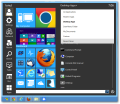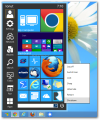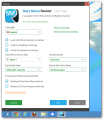Even if Windows 8 adoption rate could use some boosting, third-party developers continue to capitalize on the operating system’s lack of a start button for the desktop part.
Start Menu Reviver is one of the latest additions to the category and promises to deliver a fresh experience, in tune with the modern UI design promoted by Microsoft in the touch-friendly Start Screen.
The program has been created as a customizable application launcher that works on both Windows 7 and 8. It features a tile-based, intuitive interface ready for usage with the traditional mouse and keyboard as well as on touchscreen devices.
You may notice some strange things happening to your desktop during the installation, such as brief disappearance of the icons briefly or of the taskbar. No computer restart is required for completing the procedure. The application is free of charge.
In order to make sure that all users learn the ropes of the program, the developer included a screen with video tutorials that pops up at application launch.
Start Menu Reviver’s interface is segmented into several distinct parts that allow quick access either to installed programs and modern apps, to specific system areas, or to power options.
Just like the start button in Windows 7, there is a search bar that can help find applications or files; moreover, the function can be used to find various settings and other places on the computer. Results are returned as soon as you stop typing, regardless if the query is complete or not.
A second search function is present in the interface, in the left part of the interface; however, this activates the search in the Start Screen on Windows 8 and in Explorer on Windows 7.
On the left hand side of the menu, there are links to important areas such as the Network and Sharing Center or the Run dialog. The “Settings” tile shelters additional shortcuts, for accessing the Action Center, Control Panel Device Manager, Personalization menu, Programs and Features, the system configuration or Windows Firewall and Updates.
“Tasks” tile is the counterpart for the Alt+Tab shortcut in Windows. However, it seems to be contextual because during our tests it showed the switcher strip for modern apps when an app would be running. Otherwise, it would display the list of regular application windows. On Windows 7 it runs Aero Flip 3D feature.
Organizing the tiles in the main application window is a simple job. This can be done either by dragging and dropping the shortcuts from the expanded list of programs or by editing the tile.
A tile can be anything from a shortcut to an application, a specific location on the computer (file, folder, drive) to a web location of your choice. Furthermore, the developer makes available a set of custom icons for the tile, but you can also pick any picture. A very interesting option is the possibility to run executable files in administrator mode.
The configuration panel for Start Menu Reviver is pretty simple and allows customization of the start button icon from ten different choices or forcing the system to boot into the classic desktop.
Using the Windows key on the desktop can launch either the modern Start Screen or Start Menu Reviver, which is the default setting. Alternatively, from the modern environment it can display the program switcher.
The dashboard tile, which helps you switch to the touch-friendly part of Windows 8, has four states: enabled, hidden, disabled and dynamic. Despite our testing, we could not determine a clear distinction between the last two options because both seemed to have the same functionality.
By default, the launcher is set to expand the application side menu automatically. This can be changed so that it becomes visible only when clicking on the “Apps” button or it can be displayed at all times.
On the downside, given the large interface of the launcher, this would take a hefty chunk of the desktop screen, which affects the overall experience.
The application provides a button for power actions like logging off, switching to a different account, locking the station, putting it into hibernation or sleep, restarting or turning off the computer.
Among so many solutions filling the void left behind by Microsoft’s decision to pull out the orb in Windows 8, Start Menu Reviver is definitely a breath of fresh air. It looks clean and the design embraces the modern GUI.
On the other hand, the application shows that it is still in early development as minor glitches such as the interface persisting on the screen when clicking outside it are giving away the current state.
On the same note, during our tests accessing the recent items list displayed only shortcuts, plenty of them no longer residing on the computer. Furthermore, they were not organized by access date and time.
The Good
The application (free of charge) can force the system to boot straight into the classic desktop.
The Bad
The Truth
It does come with minor glitches that may be overlooked by the user and which could be easily fixed by the developer in a future release.
 14 DAY TRIAL //
14 DAY TRIAL // 






